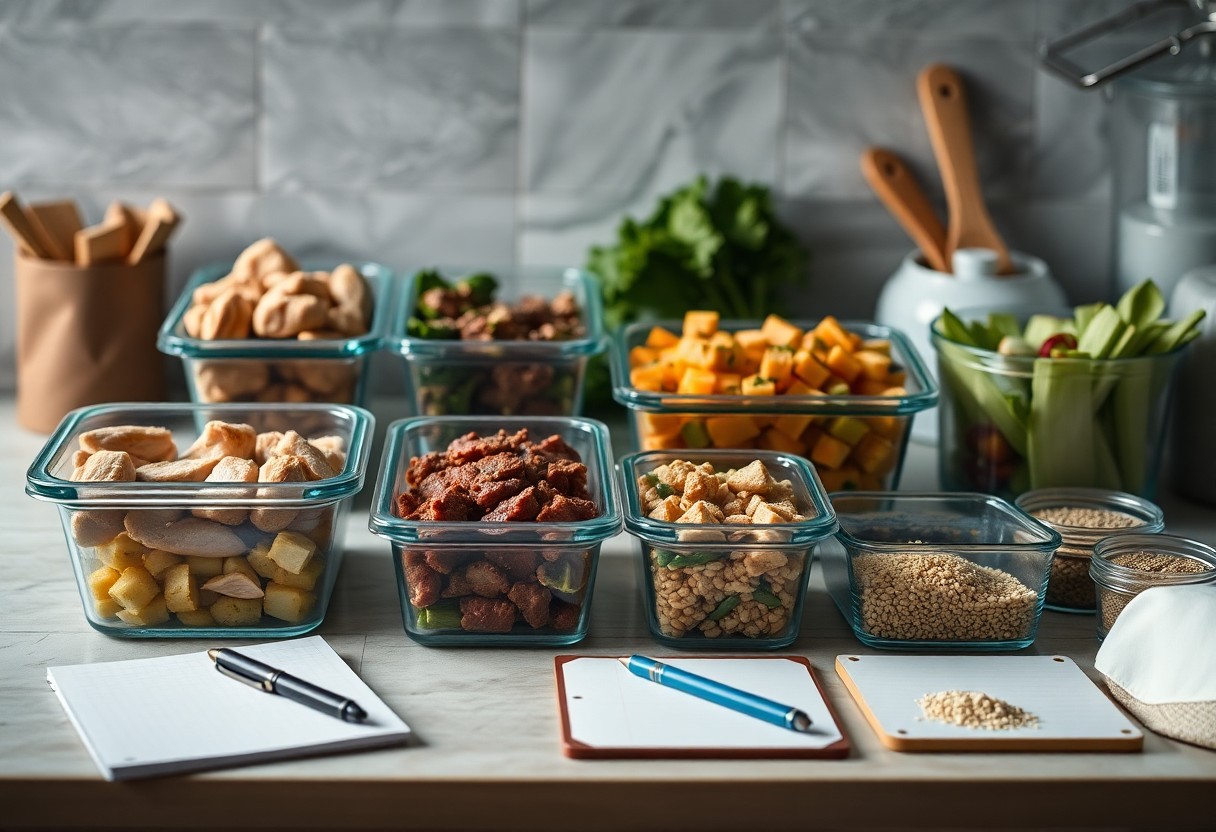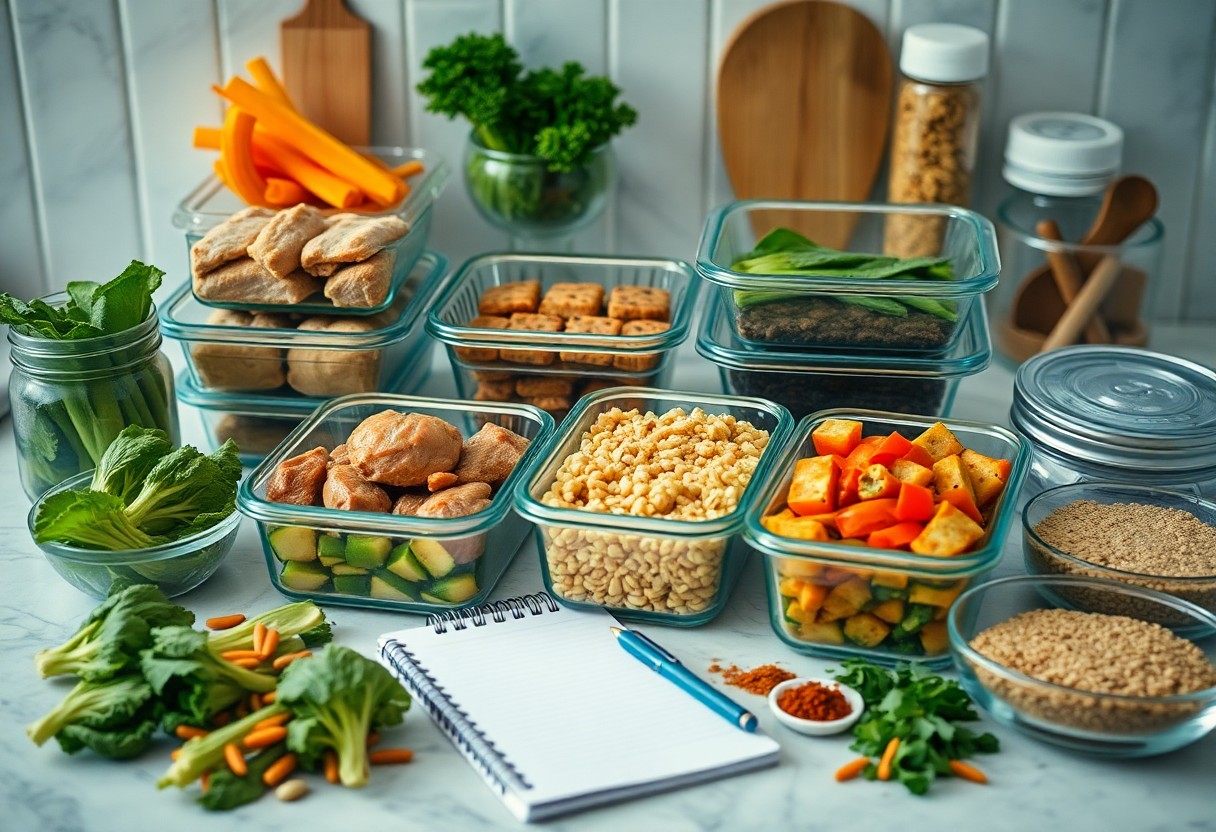Mastering batch cooking proteins goes beyond simply preparing a large quantity of chicken or beef. Precision plays a significant role in achieving the best results.
By utilizing different cooking methods—like roasting, grilling, and slow-cooking—you can create a variety of textures and flavors.
For instance, grilling chicken breasts gives a smoky flavor, while slow-cooking beef results in tender, fall-apart meat. Incorporating marinades or rubs can also enhance taste and maintain moisture throughout the week.
According to nutritionists, properly cooked proteins can last in the fridge for up to four days, allowing you to enjoy diverse meals without the daily prep hassle.
Key Takeaways:
- Select a variety of proteins such as chicken, beef, turkey, and plant-based options to keep meals interesting throughout the week.
- Utilize different cooking methods like grilling, roasting, and slow cooking to change the flavor profile and texture of your prepared proteins.
- Create a range of sauces, marinades, or seasonings to pair with proteins, allowing easy transformation from one dish to another, such as salads, stir-fries, or tacos.
Crafting Your Protein Menu for Maximum Versatility
Creating a versatile protein menu can transform your meal prep routine. Start by defining a base of proteins that can easily complement various cuisines and flavors. Think beyond the usual chicken or beef and include options like shrimp, lentils, or tempeh. Planning for diverse servings—barbecued, stir-fried, or baked—allows you to mix and match throughout the week, ensuring that you never feel like you’re eating the same dish every day.
Selecting High-Impact Proteins for Variety
Choose proteins that not only provide a plethora of nutrients but also a wide range of textures and flavors. Options such as salmon bring rich fats and umami, while turkey offers a lean choice that’s easily adaptable. Incorporating beans and legumes can add plant-based protein without sacrificing taste or heartiness.
Seasoning Strategies to Transform Flavors
Transforming basic proteins into dynamic culinary experiences hinges on your seasoning strategy. Utilizing marinades, rubs, and sauces can alter flavor profiles with minimal effort. For a Mediterranean flair, try a blend of lemon juice, garlic, and oregano for chicken. Alternatively, a marinade of soy sauce, ginger, and lime can turn shrimp into a tantalizing stir-fry ingredient.
Your seasoning arsenal is key to keeping your proteins fresh and exciting. Consider creating a “flavor wheel” with different themes—Mexican, Asian, Italian—to guide your spice selection. Simple additions like smoked paprika or fresh herbs can elevate your dish in minutes. With just a few jars of seasoning, you can go from Mexican enchiladas to Italian pasta, thereby providing endless variety in your weekly meal prep.

Mastering Cooking Techniques for Efficiency
Efficient cooking techniques not only save time but also enhance the flavors and textures of your proteins. By honing specific methods, you can simplify your meal prep and maximize variety throughout the week. Effective techniques foster consistency in results and help you create diverse dishes from a single batch of cooked proteins. Understanding the strengths of each approach is vital to streamlining your cooking process and ensuring you enjoy delicious meals all week long.
Oven Roasting vs. Slow Cooking: Pros and Cons
Choosing between oven roasting and slow cooking can significantly impact the flavor and texture of your proteins. Below is a breakdown of the pros and cons to help you decide which method might be best for your batch cooking needs.
Pros and Cons
| Oven Roasting | Slow Cooking |
|---|---|
| Quick cooking time for large cuts of meat | Tenderizes tough cuts over low, slow heat |
| Develops richer flavors from caramelization | Convenience of just setting and forgetting |
| Versatile for various vegetables | Great for meal prepping in bulk |
| Requires less monitoring during cooking | Retains moisture in proteins |
| May need a shorter cooking range for some proteins | Longer preparation time can be a drawback |
| Requires more active time in the kitchen | Can develop flavors over time |
| Less equipment needed | Less cleanup with single pot |
Quick-Prep Methods: Grilling, Sautéing, and Baking
Quick-prep methods like grilling, sautéing, and baking are excellent ways to prepare proteins in no time. These techniques get your proteins cooked quickly while locking in flavors and maintaining texture. Grilling adds a smoky dimension, while sautéing allows you to incorporate vegetables seamlessly. Baking, often perceived as a longer process, can actually be streamlined by preparing protein-rich dishes like casseroles or sheet pan meals, allowing flavors to meld beautifully.
Grilling is not just for sunny days; it’s a rapid method that gives your proteins a charred, delicious finish in a matter of minutes. Sautéing uses a hot pan with a little oil, quickly cooking your proteins while allowing you to add spices or aromatics on the fly. Baking, on the other hand, lends itself to versatile one-pan meals, providing a nutritious meal option while you focus on other tasks. Each method offers opportunities to mix and match seasonings and side dishes, making them ideal for batch cooking that keeps things fresh throughout the week.

Creative Storage Solutions to Keep Proteins Fresh
Storage solutions significantly impact the longevity and quality of your batch-cooked proteins. Utilizing the right containers allows you to maintain freshness, texture, and flavor while making meal prep easy. Consider using airtight containers and vacuum-sealed bags that minimize air exposure, preventing spoilage and freezer burn. Additionally, labeling your meals with the cooking date can help you track freshness and rotation, ensuring that you consume your proteins at their best.
Best Practices for Storing Cooked Proteins
To optimize the storage of your cooked proteins, cool them down to room temperature before placing them in the fridge or freezer. Properly separating portions for single meals not only expedites reheating but also ensures that the remaining food stays fresher longer. Aim to consume refrigerated proteins within three to four days; if you’re freezing, aim for a 2-3 month timeframe for the best flavor and texture.
Containers that Preserve Quality and Flavor
Choosing high-quality containers can be a game changer for preserving your batch-cooked proteins. Look for glass or BPA-free plastic containers with airtight lids that seal tightly. These types of containers are not only durable but also help maintain moisture levels and reduce the risk of absorbing odors from other foods. Furthermore, vacuum-sealable bags are excellent for freezing meats, as they create an air-tight seal that prevents freezer burn.
Investing in glass containers—with features such as silicone seals—also ensures you’re not just storing food but preserving *invaluable nutrition*. These containers are dishwasher-friendly, making cleanup effortless, and they’re perfect for storing proteins that you want to freeze or refrigerate. Vacuum-sealable bags can extend the shelf life of cooked proteins significantly, up to *5 times longer* than traditional methods. You can portion out proteins, seal them, and stack them easily in your freezer, helping you organize your weekly meals without clutter.
The Flavor Adventure: Reinventing Your Weekly Meals
Embracing a bold culinary journey allows you to transform your modest batch-cooked proteins into a vibrant array of meals throughout the week. By harnessing diverse flavors and cooking techniques, you can reinvent the same base proteins into entirely different dishes. Delicious meals don’t have to be repetitive; with a little creativity, you can initiate on a flavor adventure that satisfies your palate day after day. Explore different cuisines and seasonal ingredients to inspire your weekly menu, ensuring each meal feels like a brand-new experience.
Meal Pairings that Transform Protein Bases
Your batch-cooked proteins serve as an excellent foundation for many meals, but transforming those bases through complementary pairings is where the magic happens. Think of grilled chicken that can be easily elevated by serving atop a bed of zesty quinoa and fresh herbs, or with roasted vegetables drizzled in balsamic glaze for a more rustic vibe. Incorporating various grains, vegetables, and flavors can shift the entire essence of your dish, turning a single protein into three or four distinct dining options.
Dressing Up Leftovers: Sauces and Sides to Enjoy
Simple sauces and sides can ignite your creativity, breathing new life into your leftovers. A spoonful of homemade salsa or chimichurri can enhance grilled steak, while a light garlic sauce or stir-fry sauce can dress up chicken or tofu. Don’t underestimate a side of flavorful grains or fresh veggies; together, they create a harmonious balance on your plate, making each meal feel like a celebration.
Focus on sauces that align with your protein type and can be quickly prepared or even made in advance. For instance, consider a garlicky yogurt sauce for chicken or a spicy peanut sauce for tofu. These additions not only elevate the taste but also add important nutrition. Pair them with versatile sides like roasted Brussels sprouts or Mediterranean couscous, which can be adjusted throughout the week with simple tweaks like fresh herbs or lemon juice, ensuring your meals remain exciting and satisfying.
To wrap up
Summing up, mastering the art of batch cooking proteins empowers you to prepare versatile meals that sustain you throughout the week. By cooking various proteins in bulk and seasoning them differently, you can enjoy an array of flavors and dishes without the daily hassle of meal prep. Invest a little time upfront in planning your meals, and you’ll find it easier to maintain a balanced diet while keeping your taste buds happy. Your routine will be more efficient, and you’ll save money, all while indulging in delicious, homemade meals.
FAQ
Q: What are the best proteins to batch cook for variety throughout the week?
A: Some excellent options for batch cooking include chicken breast, ground turkey, tofu, and beans. Chicken can be seasoned in various ways, while ground turkey can be made into tacos, meatballs, or stir-fries. Tofu is versatile and can take on different flavors based on marinades. Beans, such as chickpeas or black beans, can be used in salads, soups, or as a protein base for grain bowls.
Q: How can I ensure my batch-cooked proteins stay fresh throughout the week?
A: To maintain freshness, let the proteins cool down to room temperature before storing them in airtight containers. Refrigerate cooked proteins within two hours of cooking and consume them within 3-4 days. For longer storage, consider freezing portions in freezer-safe bags or containers. Thaw them in the fridge before using and reheat thoroughly to ensure safety.
Q: What are some simple flavor variations I can use on my batch-cooked proteins?
A: You can create different flavor profiles with marinades and sauces. For instance, marinate chicken in teriyaki sauce for Asian-inspired meals, or use taco seasoning for Mexican dishes. For tofu, marinate in a curry paste or BBQ sauce. Additionally, adding fresh herbs, lemon juice, or different spices can create diversity without needing to cook a new protein each time.
Q: How do I effectively portion my batch-cooked proteins for meals throughout the week?
A: Portioning can be done by dividing your batch-cooked proteins into individual servings based on your dietary needs. Use meal prep containers with compartments to separate proteins from sides or veggies. Label each container with the meal or date, so you have a clear plan for the week. This helps in portion control and makes it easier to grab meals on the go.
Q: Can I mix different proteins in one batch cook session?
A: Yes, mixing different proteins can add more variety to your meals. Just be mindful of cooking times and techniques, as some proteins may require different methods. For example, roast chicken and bake tofu together, as they can both be roasted in the oven with different seasonings and will cook at similar times. However, ensure all proteins reach the appropriate internal temperature for safety.

I’m passionate about making home cooking simple, enjoyable, and stress-free. Through years of hands-on experience, I share practical tips, smart meal prep ideas, and trusted kitchen essentials to help you feel more confident in the kitchen every day.
